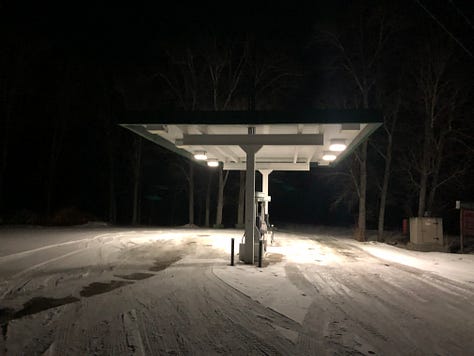Rooftop Solar is a Major Economic Benefit to California
A recurring counter-narrative that it shifts costs from affluent customers to non-affluent customers is based on distorted logic, motivated reasoning, and faulty assumptions
TL; DR Version: the Cost-Shift Fallacy
A recurring criticism of rooftop solar policy in California (a.k.a. Net Energy Metering) is that it shifts costs from from more affluent utility customers to less affluent ones.
But I’ve watched this melee for a few years now, and my impression is that two major factors are distorting most critical analyses of California distributed solar policy:
Regulators continue to hammer flimsy socioeconomic theory (“equity”) into their ratemaking principles to generate preferred outcomes for select demographics. The end result is an eternal recurrence of “unintended” consequences.
The current flavor of California progressive governance stipulates that massive, utility-scale renewables are the key to a decarbonized economy. And a centralized green economy provides major moneymaking opportunities for investor-owned utilities, whose capital costs can be recovered from ratepayers in perpetuity. Thus IOUs have every incentive to propagate the cost-shift argument.
Interestingly, a new analysis by Bay Area economist Richard McCann suggests that rooftop solar represents a benefit to ratepayers, to the tune of $2.3 billion.
McCann’s work was cited in a recent letter sent to Gavin Newsom by 12 energy professionals, who requested that the governor reconsider language in Executive Order N-5-24, which makes a superficial attempt to address state energy affordability issues while defaulting to the “cost-shift” argument.
“Equity”
Two years ago when the CPUC was restructuring its rooftop solar tariff from NEM 2.0 to NEM 3.0,1 regulators circulated the cost-shift narrative. But this narrative always seemed dubious — after all, there are innumerable cost shifts that occur across many regulatory proceedings; why focus on this one?
There are a few reasons, no doubt, but I suspect the motivation came partially as tribute to the equity gods.
During the restructuring of the NEM tariff, a frequently-cited study said that solar homeowners in California were most likely to be whites who earn six-figure incomes. Such metrics quickly became a touchstone for regulators (or any stakeholder with an interest in utility-scale solar).
However…an update to the study a few months later conceded that income and racial inequality in the home solar market were diminishing. In other words, the market dynamics of rooftop solar were increasingly healthy and providing opportunity for more and more demographics, albeit with some messiness, just like any other market that moves from nascent to mainstream.
But the state revamped the NEM tariff anyway — based largely on the cost-shift argument — and, if you believe certain vested interests, distributed solar is now in trouble.
To wit:
Solar sales have allegedly fallen between 66% and 83%;
New solar installations dropped by 80% in 2023; and
Interconnection request data reveals a 66%-to-83% reduction in solar sales year-over-year after NEM 3.0’s implementation.
Rooftop solar proponents also claim that a sizable number of solar installation companies have since downsized or shut down, smaller companies and startups face pronounced growing pains, and Aurora Solar, which provides solar software products, laid off 20% of its workforce.
The Economics of Decarbonization
Meanwhile, another problem exists beyond the desire to preordain economic outcomes based on demographics.
The current manifestation of progressive power tilts toward centralized bureaucracies and administrative hegemony, such that distributed generation will increasingly be viewed as a threat to the grid.2
This sentiment is clear among popular progressive tastemakers. A few years ago green-energy shitlib Dave Roberts warned that a massive expansion of rooftop solar in California could fail to increase the state’s net amount of solar, and worse, might displace centralized solar altogether.
OMG, gasp, summon the fainting couches.
In retrospect, comments like Roberts’ seem predictive of how governance would skew in the years to follow. The economics of decarbonization, as favored by highly-credentialed state decision-makers with pronouns in their email signatures, require utility-scale solar that is spread across large swathes of land, despite the fact that California’s cities have 10 billion square feet of rooftop space that is available for photovoltaics.3
Utilities are happy to participate in this arrangement because doing so increases their ratebase (i.e., the total value of their assets minus accumulated depreciation) and makes their shareholders richer. Thus it should come as no surprise that IOUs are some of the biggest proponents of the cost-shift argument.
However, a new analysis suggests that not only is the cost-shift argument wrong, it’s catastrophically wrong, and rooftop solar actually benefits the state to the tune of $2.3 billion.
The Cost-Shift Canard
Bay Area economist Richard McCann recently made significant adjustments to perceived errors in an August 2024 study by the CPUC’s Public Advocates Office (PAO), which doubled down on the cost-shift argument.
The PAO’s study concluded that, by the end of 2024, the NEM tariff would cost non-solar customers $8.5 billion, a figure that has doubled since 2021. According to PAO, this doubling was driven by a surge in interconnections for new rooftop solar systems prior to the phase-out NEM 2.0 and higher compensation to rooftop solar customers for the energy their systems generate.
McCann challenged PAO’s findings with his own study. His methodology seems rigorous and IMHO completely dismantles the cost-shift argument (although I agree with him on little else).
In a nutshell, McCann says:
PAO relied on bundled rates to calculate its cost-shift figures but failed to account for Time-of-Use rates. This is a major oversight since rooftop solar generation aligns with periods when electricity prices are higher (e.g., afternoons), meaning that exported solar energy offsets higher-priced utility generation. Thus, adjustments for accurate generation timing and associated low-income subsidy discounts (i.e, the CARE program) added $2.457 billion in benefits not initially recognized by PAO.
PAO made another mistake in its cost-shift calculations via the inclusion of energy that solar customers consume on-site. This energy does not flow through to the grid and therefore does not represent a revenue loss for utilities. Correcting this oversight removed a whopping $3.989 billion in phantom costs.
Rooftop solar installations have historically reduced utilities’ capital and operational costs by lowering peak load demands and decreasing the need for infrastructure investments. Over time, this has generated utility savings of $2.165 billion. These benefits flow through to all ratepayers but were ignored by PAO.
Solar customers who qualify for low-income CARE subsidies reduce their consumption of subsidized energy by generating their own power. This reduces the subsidy burden on non-CARE ratepayers. McCann’s analysis identifies $719 million in savings associated with reduced CARE subsidy costs.
Rooftop solar customers contribute significantly to utility fixed costs via their monthly bills, which often range from $80 to $160 even after installing solar panels. These payments contribute to grid maintenance and infrastructure expenses and offset some costs that utilities attribute to solar adoption. Accounting for these costs adds $1.420 billion in benefits.
Canary Media and PV Magazine both have pieces that elaborate on McCann’s study (available here and here).
**One last thought, delivered in cryptic fashion**
There’s something called the POSIWID principle, which stipulates that a system's true purpose is reflected in its actual outcomes rather than its stated objectives or intentions. I think people in state leadership should reflect on this concept when examining California’s many troubles.
AESTHETIC INFRASTRUCTURE
I recently stumbled upon a great photo essay by Charles Xelot, which documents the Yamal LNG Project, a giant, integrated venture for natural gas production, liquefaction, and shipping above the Russian portion of the Arctic Circle.
Highly recommended. Below are some of the photos.
NEWS & NOTES
GEOTHERMAL INVESTMENT GOING UP: Multiple California agencies (CPUC, CARB, and CEC) convened in November to discuss utilities’ progress toward meeting Senate Bill 100, which mandates that California reach 100% renewables and zero-carbon energy by 2045. The agencies claim that California is 60% ahead of schedule on its clean-energy targets and has added over 23 gigawatts of clean-energy resources in the past four years, with an additional 19 GW under contract. A notable remark came from a representative of Sonoma Clean Power, who said the geothermal component of the CPUC’s 2021 “Mid-Term Reliability” mandates, which require load-serving entities to procure 11.5 GW of net qualifying capacity from renewable and zero-emission resources by mid-decade, have sent “shockwaves through the geothermal industry and catalyzed significant investment…”
GENERAL INTEREST LINKS
BEYOND the FRONTIER: Daniel Miller writes: “We need new forms of thinking and practice across all creative mediums: a new seriousness, a new discipline, a new passion. We need a new art and a new avant-garde, which abandons the exhausted sterility of conceptual art and returns to the spirit of poetry.”
CIRCLING the DRAIN: Daniel Kalder discusses the anticlimax of visiting the Diana, Princess of Wales Memorial Fountain: “The Diana, Princess of Wales Memorial Fountain was shit; shit beyond language, shit beyond imagination…I had tumbled into the heart of a collapsed star.”
HERESY COSTS: First Things has a very good review of Nick Cave’s book, And the Ass Saw the Angel: “Extreme devoutness may be a prerequisite for holiness, as piety for sanctity, but should not be mistaken for it. Our mental maps of reality, our delusions and disordered dogmas…really matter. How you see the world will likely determine how you leave it.”
HYPERAMERICA: “America, along with its economy, market, culture, and theology, can be viewed not as a static, fixed system but as a shifting, cybernetic meta-organism that interacts with and intensifies apocalyptic feedback loops. American hegemony is, consequently, not merely a question of the military power and cultural dominance of a single nation. America is a mythic force that shapes geopolitics through a Promethean will.” (Tobias Huber)
LOST & FOUND in UPPER MICHIGAN: This is a nice piece on my cousin, a Northern Michigan musician who has languished in obscurity for decades and may have botched his big-break opportunity due to public drunkenness. Now, thanks to the Internet, he has a cult following online.
RAPID ONSET POLITICAL ENLIGHTENMENT: Good Tablet piece on how Barack Obama and friends were defeated by the omnipotent political machinery that they themselves built. “Lost in the hypercharged mirror world that they had created, they decided that having made themselves cool also made them right, and that evidence to the contrary could be safely dismissed as a ‘right-wing talking point.’ Obama’s operatives shared the same character flaw as their master, a kind of brittle, Ivy League know-it-all-ness that demanded that they always be the smartest person in the room.”
2024 IN REVIEW
What a year — I bounced all around, from the base of the Bighorn Mountains in Wyoming to a village in the Andes to Houston, Texas to consort with falconers, Trumpists, Ecuadorian farmers, pilots, poets, and cowboys.
January set the tone. As I set off for Wyoming, I watched an arc flash illuminate the night sky in my city, due to a substation explosion during an ice storm. This foreshadowed a weekend where friends and I smashed through an icy creek and jumped into the glacial run-off water for a violent rearrangement of our relationship with everything. Then we sat by the fire, ate prime rib, and discussed who we would kill for, how to find hidden folds in the cartographical matrix, and when to bust your friends out of federal prison (in Minecraft).
January is now here again. Happy New Year.




















NEM 3.0 cut compensation rates for exporting solar generation to the grid by about 75%.
The tendency toward centralized modes of governance is surfacing with AI too, and includes some surprising plot twists, such as a growing appreciation among progressive for nuclear power and its ability to feed the hegemonic machines.
These roofs are sufficient to generate approximately 275,000 gigawatt-hours per year. For comparison, California’s total electricity consumption in 2022 from all sources was 287,220 gigawatt-hours.










